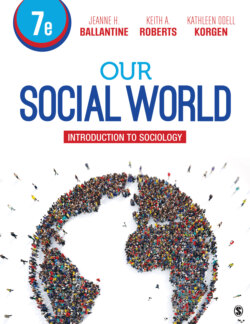Читать книгу Our Social World - Kathleen Odell Korgen - Страница 49
На сайте Литреса книга снята с продажи.
Social Structures
ОглавлениеPicture the human body, held together by bones and muscles. The organs or units that make up that body include the brain, heart, lungs, and kidneys. In a similar manner, social units are interconnected parts of the social world ranging from small groups to societies. These social units include dyads (two people); small groups like the members of a family; community organizations including schools and religious groups; large-scale organizations such as political parties or state and national governments; and global societies, such as the United Nations.
All of these social units connect to make up the social structure—the stable patterns of interactions, statuses (positions), roles (responsibilities), and organizations that provide stability for the society and bring order to individuals’ lives. Think about these parallels between the structure that holds together the human body and the structure that holds together societies and their units.
Sometimes, however, the units within the social structure are in conflict. For example, a religion that teaches that some forms of birth control are wrong may conflict with the health care system regarding how to provide care to women. This issue has been in the U.S. news because many religious organizations and religious business owners have fought against the requirements of the 2010 Affordable Care Act in the United States that employers provide birth control to those who wish to receive it.
Social institutions are organized, patterned, and enduring sets of social structures that provide guidelines for behavior and help each society meet its basic survival needs. Think about the fact that all societies have some form of family, education, religion, politics, health care, and economics; in more complex societies there are also essential structures that provide science, media, advanced health care, and a military. These are the institutions that provide the rules, roles, and relationships to meet human needs and guide human behavior. They are the units through which organized social activities take place, and they provide the setting for activities essential to human and societal survival. For example, we cannot survive without an economic institution to provide guidelines and a structure for meeting our basic needs of food, shelter, and clothing. Likewise, society would not function without political institutions to govern and protect its members. Most social units fall under one of the main institutions just mentioned.
Like the human body, society and social groups have a structure. Our body’s skeleton governs how our limbs are attached to the torso and how they move. Like the system of organs that make up our bodies—heart, lungs, kidneys, and bladder—all social institutions are interrelated. Just as an illness in one organ affects other organs, a dysfunction in one institution affects the other institutions. A heart attack affects the flow of blood to all other parts of the body. Likewise, if many people are unable to afford medical treatment, the society is less healthy, and there are consequences for families, schools, workplaces, and society as a whole.
▲ All social institutions are interrelated, just as the parts of the body are interdependent: If the skeletal system of the body breaks down, the muscular system and nervous system are not far behind.
© AFP/Stringer/Getty
The national society, one of the largest social units in our model, includes a population of people, usually living within a specified geographic area, connected by common ideas and subject to a particular political authority. It also features a social structure with groups and institutions. In addition to having relatively permanent geographic and political boundaries, a national society has one or more languages and a unique way of life. In most cases, national societies involve countries or large regions where the inhabitants share a common identity as members. In certain other instances, such as the contemporary United Kingdom, a single national society may include several groups of people who consider themselves distinct nationalities (e.g., Welsh, English, Scottish, and Irish) and those individuals from former colonies. Such multicultural societies may or may not have peaceful relations.
▲ This refugee mother and child from Mozambique represent the smallest social unit, a dyad. In this case, they are trying to survive with help from larger groups such as the United Nations.
© Getty Images/Peter Turnley/Contributor
Thinking Sociologically
Can you think of any human activities that do not fall into one of the institutions just mentioned? How might change in one national institution, such as health care, affect change in other national institutions, such as the family and the economy?
